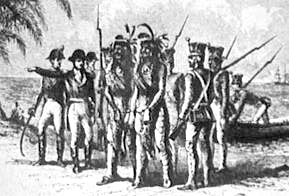Courtesy of the Florida Memory Project. Click here or on the image above to read the full article.
Undated photo, likely from the early 1800s, shows a wooden well structure and fruit trees in front of the Slave Cabins at Kingsley Plantation.
Courtesy of the National Parks Service. Click here or on the image above to read the full article and see maps of the plantation.
Note the orientation of slave cabins and proximity to main house at both Magnolia Plantation (Cane River Creole National Historical Park, left) and Kingsley Plantation (Timucuan Ecological and Historic Preserve, right).
Courtesy of the National Parks Service. Click here or on image above to read full article.
Click on the link above to explore more about "Negro Fort"
By the spring of 1816 there were more than
300 people living on farms that extended for
miles up the Apalachicola River from the Fort
at Prospect Bluff or "Negro Fort" (as it was
called in 1816). Most of these farms were
occupied by African Americans, many of
whom had escaped from slavery in the
United States or Spanish Pensacola.
Florida’s Negro Fort/Part 3/Africans in America http://www.pbs.org/wgbh/aia/part3/3p1643.html


"Back when Britain controlled Florida, the British often incited Seminoles against American settlers who were migrating south into Seminole territory. These old conflicts, combined with the safe-haven Seminoles provided black slaves, caused the U.S. army to attack the tribe in the First Seminole War (1817-1818), which took place in Florida and southern Georgia. Forces under Gen. Andrew Jackson invaded Spanish Florida, attacked several key locations, and pushed the Seminoles farther south into Florida.

St. Marks, Fla., April 1818 -- Two Seminole chiefs, or micos are captured by Jackson's forces who used the ruse of flying the British flag to lure the Indians to them.
Image from the Florida State Archives.
Finally, after several official and unofficial U.S. military expeditions into the territory, Spain formally ceded Florida to the United States in 1821, according to terms of the Adams-Onís Treaty.
As soon as the United States acquired Florida, it began urging the Indians there to leave their lands and relocate along with other southeastern tribes to Indian Territory, present-day Oklahoma. Some Seminole leaders signed a treaty in 1832, and part of the tribe moved. But other Seminoles refused to recognize the treaty and fled into the Florida Everglades."
Courtesy of The Florida Department of State Documents online. Click here to read the full article.
Fort Gadsden (Wikipedia)
Fort Gadsden National Historic Site (Apalachicola National Forest)
Fort Gadsden and the “Negro Fort” on the Apalachicola (ExploreSouthernHistory.com)
Historic Sites (Apalachicola National Forest)
History of Florida (Wikipedia)
